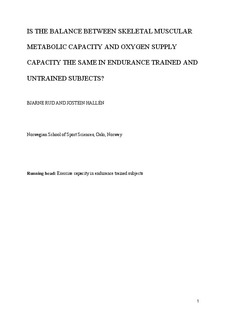Is the balance between skeletal muscular metabolic capacity and oxygen supply capacity the same in endurance trained and untrained subjects?
| dc.contributor.author | Rud, Bjarne | |
| dc.contributor.author | Hallén, Jostein | |
| dc.date.accessioned | 2009-12-11T10:37:12Z | |
| dc.date.issued | 2008-12-02 | |
| dc.identifier | Seksjon for fysisk prestasjonsevne / Department of Physical Performance | |
| dc.identifier.citation | European Journal of Applied Physiology. 2009, 105(5), 679-685 | en |
| dc.identifier.issn | 1439-6319 | |
| dc.identifier.uri | http://hdl.handle.net/11250/170503 | |
| dc.description | I Brage finner du siste tekst-versjon av artikkelen, og den kan inneholde ubetydelige forskjeller fra forlagets pdf-versjon. Forlagets pdf-versjon finner du på www.springerlink.com: http://dx.doi.org/10.1007/s00421-008-0947-8 / In Brage you'll find the final text version of the article, and it may contain insignificant differences from the journal's pdf version. The original publication is available at www.springerlink.com: http://dx.doi.org/10.1007/s00421-008-0947-8 | en |
| dc.description.abstract | We attempted to test whether the balance between muscular metabolic capacity and oxygen supply capacity in endurance-trained athletes (ET) differs from that in a control group of normal physically active subjects by using exercises with different muscle masses. We compared maximal exercise in nine ET subjects [Maximal oxygen uptake (VO(2)max) 64 ml kg(-1) min(-1) +/- A SD 4] and eight controls (VO(2)max 46 +/- A 4 ml kg(-1) min(-1)) during one-legged knee extensions (1-KE), two-legged knee extensions (2-KE) and bicycling. Maximal values for power output (P), VO(2)max, concentration of blood lactate ([La-]), ventilation (VE), heart rate (HR), and arterial oxygen saturation of haemoglobin (SpO(2)) were registered. P was 43 (2), 89 (3) and 298 (7) W (mean +/- A SE); and VO(2)max: 1,387 (80), 2,234 (113) and 4,115 (150) ml min(-1)) for controls in 1-KE, 2-KE and bicycling, respectively. The ET subjects achieved 126, 121 and 126% of the P of controls (p < 0.05) and 127, 124, and 117% of their VO(2)max (p < 0.05). HR and [La-] were similar for both groups during all modes of exercise, while VE in ET was 147 and 114% of controls during 1-KE and bicycling, respectively. For mass-specific VO(2)max (VO(2)max divided by the calculated active muscle mass) during the different exercises, ET achieved 148, 141, and 150% of the controls' values, respectively (p < 0.05). During bicycling, both groups achieved 37% of their mass-specific VO2 during 1-KE. Finally we conclude that ET subjects have the same utilization of the muscular metabolic capacity during whole body exercise as active control subjects. | en |
| dc.format.extent | 132312 bytes | |
| dc.format.mimetype | application/pdf | |
| dc.language.iso | eng | en |
| dc.publisher | Springer | en |
| dc.subject | exercise capacity | en |
| dc.subject | knee extensions | en |
| dc.subject | bicycling | en |
| dc.subject | exercise limitations | en |
| dc.subject | VO2 limitations | en |
| dc.subject | VO2max | en |
| dc.title | Is the balance between skeletal muscular metabolic capacity and oxygen supply capacity the same in endurance trained and untrained subjects? | en |
| dc.type | Peer reviewed | en |
| dc.type | Journal article | en |
| dc.subject.nsi | VDP::Mathematics and natural science: 400::Basic biosciences: 470 | en |
| dc.source.pagenumber | 679-685 | en |
| dc.source.volume | 105 | en |
| dc.source.journal | European Journal of Applied Physiology | en |
| dc.source.issue | 5 | en |
Tilhørende fil(er)
Denne innførselen finnes i følgende samling(er)
-
Artikler / Articles [2096]
